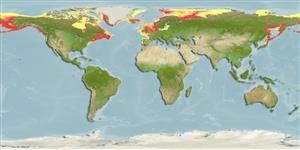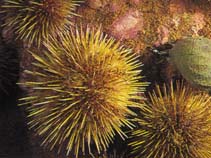Strongylocentrotus droebachiensis (Müller, 1776)
Northern sea urchin| Native range | All suitable habitat | Point map | Year 2050 |

|
| This map was computer-generated and has not yet been reviewed. |
| Strongylocentrotus droebachiensis AquaMaps Data sources: GBIF OBIS |
Mandar um arquivo com seu (sua) Fotos
| Todas as fotos | Imagem do Google | Strongylocentrotus droebachiensis
| Todas as fotos | Imagem do Google | Strongylocentrotus droebachiensis
Classification / Names Common names | Synonyms | CoL | ITIS | WoRMS
| Camarodonta | Strongylocentrotidae
Environment: milieu / climate zone / depth range / distribution range Ecologia
; intervalo de profundidade 0 - 300 m (Ref. 78719), usually 0 - 50 m (Ref. 113749). Temperate; 79°N - 37°N, 127°E - 97°E
Distribuição Países | Áreas FAO | Ecossistemas | Ocorrências | Introduções
Northern Pacific, Northern Atlantic and the Arctic. Temperate to polar.
Length at first maturity / Tamanho / Peso / Idade
Maturity: Lm 2.5 range ? - ? cm Max length : 10.0 cm WD macho/indeterminado; (Ref. 865); Idade máx. registada: 45 anos (Ref. 90469)
It is found on rocks and soft bottoms from the intertidal to a depth of 300 meters (Ref. 865). Also in tidepools in the low intertidal, found on bedrock outcrops, boulders, cobbles, occasionally in sand (Ref. 113749). Primarily feeds on seaweeds, with few feeding on eelgrass (Ref. 106946). Also feeds on bivalves, gastropods and benthic crustaceans (Ref. 85579).
Life cycle and mating behavior Maturidade | Reprodução | Desova | Ovos | Fecundidade | Larvas
Members of the class Echinoidea are gonochoric. Fertilization is external. Brooding is common, eggs are held either on the peristome, around the periproct or deep into the concavities on the petaloids. Life cycle: Embryos develop into planktotrophic larvae (echinoplateus) and live for several months before they sink to the bottom using their tube feet to adhere on the ground where they metamorphose into young urchins.
Referência principal
Referências | Coordenador | Colaboradores
Berkes, F., T.P. Hughes, R.S. Steneck, J.A. Wilson, D.R. Bellwood, B. Crona, C. Folke, L.H. Gunderson, H.M. Leslie, J. Norberg, M. Nyström, P. Olsson, H. Österblom, M. Scheffer and B. Worm. 2006. (Ref. 861)
Status na Lista Vermelha da IUCN (Ref. 130435)
Status no CITES (Ref. 108899)
Not Evaluated
CMS (Ref. 116361)
Not Evaluated
Perigo para os humanos
Uso pelos humanos
Pescarias: espécies comerciais
| FishSource | Sea Around Us
Ferramentas
Mais informação
Fontes da internet
BHL | BOLD Systems | CISTI | DiscoverLife | FAO(Publication : search) | Fishipedia | GenBank (genoma, nucleotídeo) | GloBI | Gomexsi | Google Books | Google Scholar | Google | PubMed | Árvore da vida | Wikipedia (Ir para, procura) | Registro zoológico
Estimates based on models
Preferred temperature
(Ref. 115969): 0.8 - 10.2, mean 5.2 (based on 977 cells).
Resiliência
(Ref. 69278):
Elevada, tempo mínimo de duplicação da população menor que 15 meses (K=0.12-0.84; tm=2.5; tmax=45).
Nutrients: Calcium = 126 [75, 177] mg/100g; Iron = 5.08 [1.67, 7.92] mg/100g; Protein = 12%; Omega3 = 0.331 [0.263, 0.400] g/100g; Selenium = 0.04 [48.48, 67.17] μg/100g; VitaminA = 0 μg/100g; Zinc = 1.97 [0.92, 3.02] mg/100g (wet weight).



